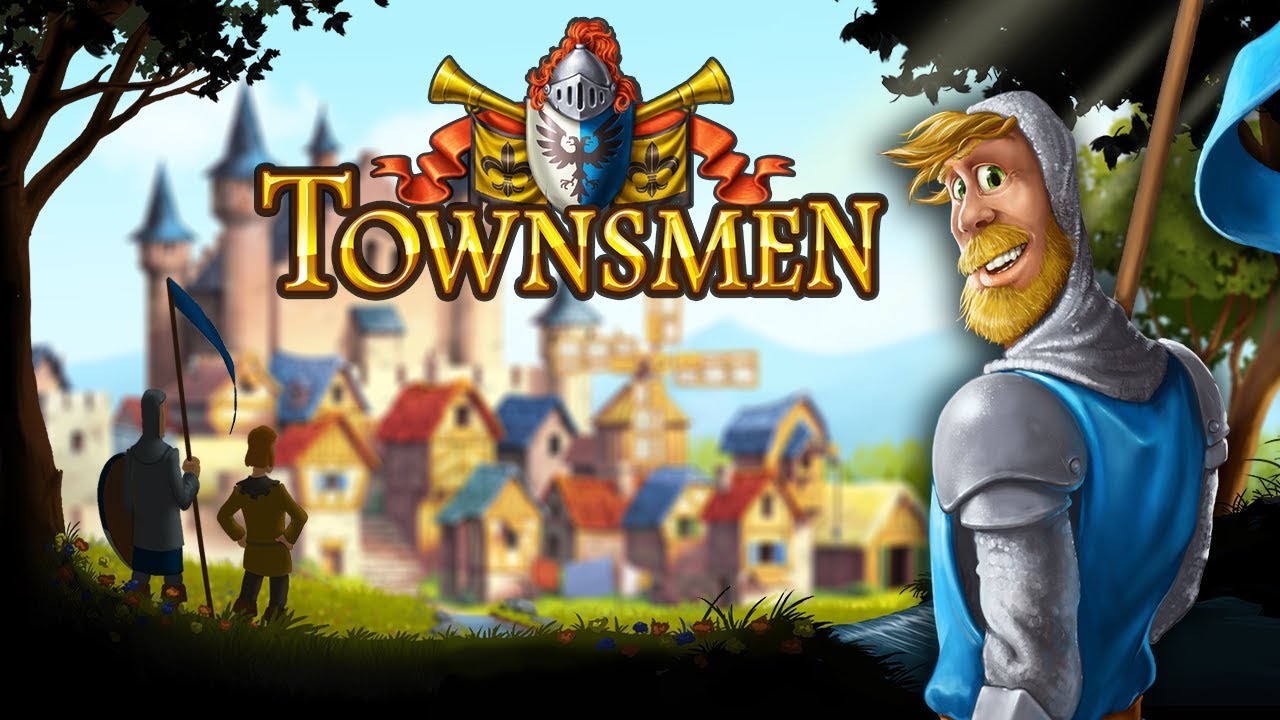
Handygames have undertaken a rare feat in today’s gaming landscape, not so much out of difficulty, but out of resisting temptation. Townsmen was an app game for smartphones, yet I found no need to get the torches and pitchforks this time. There is no trace of invasive ads or premium currency to be seen on the console versions, almost to the point I would consider this a full blown remake. They have turned a smartphone game into a traditional game, and a pretty good one at that.
Townsmen
Publisher: Handygames
Developer: Handygames
Platform: Windows PC, Smartphone, Switch (reviewed)
Release Date: November 9th 2018 (Switch), November 30th (Windows PC)
Players: 1
Price: $19.99

Townsmen is a strategy and city building game set in medieval times. You create homes, farms, and other buildings; all feeding into one another. Homes for example house people, who can work in places like farms, which can grow wheat, which in turn can be given to a windmill to make flour, and then to a baker to make bread. All while keeping them happy and safe from bandits.
The difficulty comes from storage and timing. A building can only hold so much of what it is making, and yet more workers are needed to carry the objects from one place to the other- at the world’s most achingly slow pace. This also applies when building a new structure. Before you know it, you end up with three different projects begging for wood and it is all your fault – and that’s great!
It certainly does not hold back, even in its tutorial. Rather than a step-by-step of what you need to do, it feeds you the very basics while leaving you to work everything else out. The fact this used to be an app game boggles my mind. Even some AAA titles refuse to let go of your hand.
With the exception of specific scenarios, you do not get a game over immediately when you fail. It’s more of a slow burn, as your townsfolk (called Townies) get so fed up they begin to strike or even move away. Production starts to slow down and it becomes obvious a restart is in order.
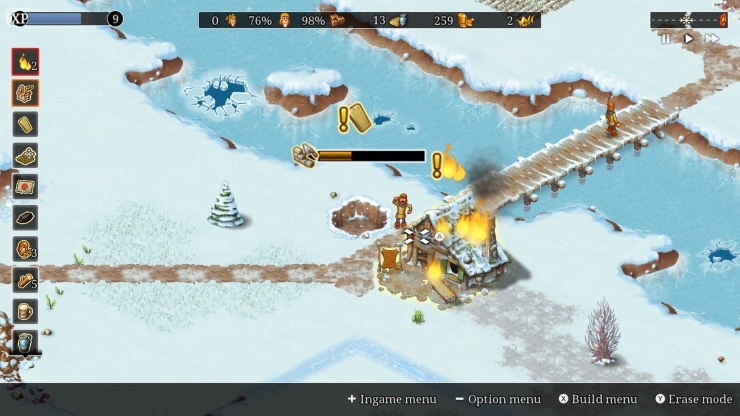
Outside the tutorial the game has several scenarios, and even a sandbox mode with no over-arching goal. All of the above have missions, such as producing a certain resource or constructing specific buildings. Completing these missions earns you prestige.
On paper, prestige sounds like a premium currency. You can use it to finish construction instantly with no cost to your resources – ideal to tie into fast -moving development strategies, or when you find yourself suddenly in need of a warehouse, fire watch or guard tower. However, there is absolutely no way to buy prestige with real money, nor does it carry over from map to map.
An interesting factor that does carry over from each map is your level. Completing missions and general play earns you EXP. At various levels you can perform research, which improves how things work. For example, a trader can sell things to you for cheaper prices, or you can assign workers to replenish a mine.
It is a great way to encourage and reward replaying maps over and over, though held back by the fact you have no real way to gauge how well you have done in a scenario. I certainly do not pine for the Angry Birds style three-star system, but some form of scoring would have been nice to know if I was a great ruler, or barely scraped by.
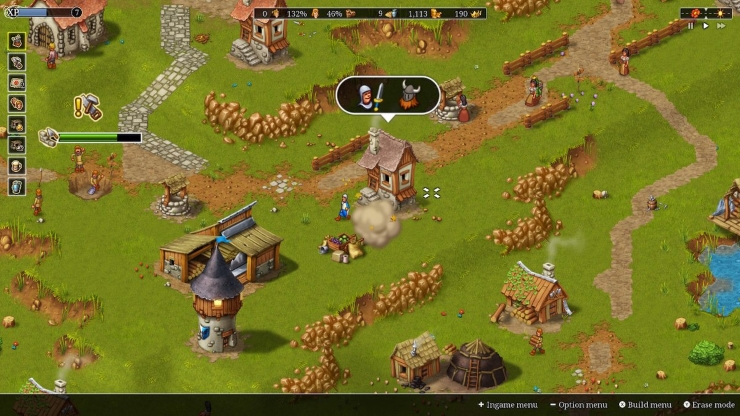
Gameplay wise, this is not your typical “ant-farm” style game you can while away the hours watching. If you let the game play out normally, it is painfully slow with not much in way of interesting animations. You can fast-forward the action, which can still feel slow at times when nothing is going on or you are begging for taxes to come in quicker.
Outside of these lulls, the game commanded my complete attention. Weighing up the pros and cons of what to develop next, while balancing food, people, happiness, taxes, and resources; I thoroughly enjoyed how much I had to consider.
My only major qualm is that some info is not in the game, such as food per hour consumed and produced. It is sorely missed here, and while it is not the deepest compared to titans of its genre, it could have pushed the meta game a little higher.
There are some more minor gripes gameplay wise. The tint to show a building is degrading is very minor and can often be missed, leading you to neglect a building until you get a warning at a critical stage.

When building roads the game shows you the most efficient path between two points- dodging obstacles and warning you if the route is impossible. Unless you cannot afford it, then you get no predictive pathing shown. Roads cost per-tile, so not knowing how much I needed to save up and where the path would go in my ever-booming real estate was an annoyance.
Townsmen also does not warn you if you are about to put down a building right in the path of one of your villagers- only after it has walked up to your lovely new statue, cursed the heavens, then went back to its task the long way ’round. These are annoyances, but nothing you cannot deal with over time.
The tutorial also exposed the flaw in the games messages from NPCs. When one NPC’s text box ends, the gameplay briefly starts again before the next one speaks up. It’s just a long enough pause to be annoying. I even had rare occasions where I completed a quest and had to wait for a message from an NPC to trigger the completion flag.
All of these gripes are nitpicks compared to what the game was back when it was a mobile game. It is no stretch to say the game has improved leaps and bounds from what it once was, shaking off the shackles of how it used to play and look.
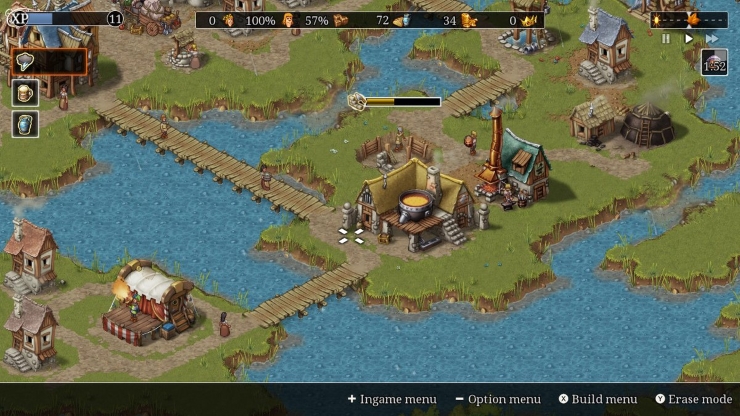
While the art-style is the same, the UI and nearly every asset has been totally redrawn. It looks great even when you zoom in close, without a trace of pixelation or line-art. Though, the brown and white brick work can on rare occasion make it hard to find a specific building at a glance. Usually you can remember where you put them pretty well though.
I did have one incident where the construction of a new building (which looks like a pit) was perfectly concealed behind the building in front of it. I was able to access it through the events menu (as no worker had been assigned to it), but otherwise I do not think I would have been able to.
The UI is tiny on TV screens, at least on the Switch version. I had to squint to see certain symbols and text. The UI is a much more appropriate size when in handheld mode however, which makes it even more baffling the TV mode did not use a similar size of UI.
This is still leagues better than the ugly mobile style UI the game used to have. No giant buttons obscuring most of the screen, crisp and clean menus- everything has a minimalist style to be as unobtrusive as possible.
Steam still uses some elements of the older UI, and while it is drawn to match a ye-olde style better, I think I prefer the minimalist approach to the Switch version. Though this may just be bias due to experiencing it first.
The game’s music and sound effects are also better than expected. The music is soothing and adapts based on the season, and moussing over specific buildings generates different sound effects. Not to mention the strange sim-lish style language of your townies. If you didn’t need to concentrate on what to build next, I would almost dare call it “comfy”.
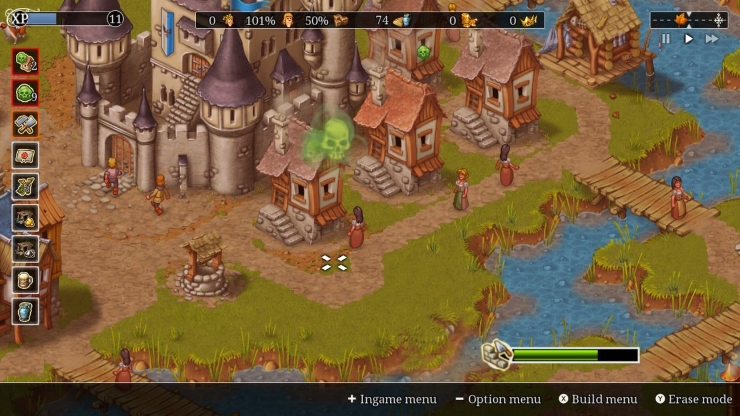
Overall it is easy to over-praise Townsmen when comparing it to its origins. When compared to similar games on mobile or in-browser it is a masterpiece, ditching elements that held it down. When comparing it to those on PC and console however, it is still a great time that I am positive will gain a dedicated fan-base.
To those who only play games that get the loftiest of scores, I beg of you to still try this if it sounds like something you would enjoy. This is not to encourage other developers to move away from mobile style games, but because Townsmen does nearly everything right. It is the definition of an indie underdog that has a real chance to become something special next time the developers go to town.
Townsmen was reviewed on Nintendo Switch using a review copy provided by Handygames. You can find additional information about Niche Gamer’s reviews/ethics policy here.
The Verdict: 7.5
The Good:
- Abandons mobile-game conventions and mechanics.
- Well balanced city-building gameplay that requires upmost planning and attention.
- Very good 2D sprites and music.
The Bad:
- UI can be too small on TV.
- Can sometimes be lacking information for some.
- The “slow burn” to fail may be an annoyance.